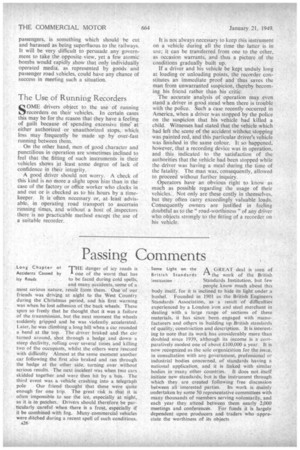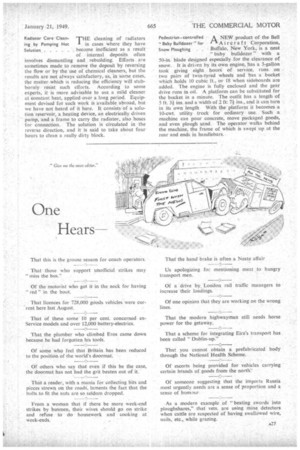Passing Comments
Page 2

Page 3

If you've noticed an error in this article please click here to report it so we can fix it.
Long Chapter oi THE danger of icy roads is
Accidents Caused by I one of the worst that has Icy Roads to be faced during cold spells,
and many accidents, some of a most serious nature, result from them. One of our friends was driving at night to the West Country during the Christmas period, and his first warning was when he lost adhesion of the back wheels. These spun so freely that he thought that it was a failure of the transmission, but the next moment the wheels suddenly gripped and he was violently accelerated. Later, he was climbing a long hill when a car rounded a bend at the top. The driver braked and the car turned around, shot through a hedge and down a steep declivity, rolling over several times and killing two of the occupants, whilst the others were rescued with difficulty Almost at the same moment another car following the first also braked and ran through the hedge at the other side, turning over without serious results. The next incident was when two cars skidded together and were then hit by a bus. The third event was a vehicle crashing into a telegraph
pole Our friend thought that these were quite enough for one trip. The great risk is that it is often impossible to see the ice, especially at night, as it is in patches. Drivers should therefore be particularly careful when there is a frost, especially if it be combined with fog. Many commercial vehicles were ditched during a recent spell of such conditions. A26
Some Light on the A GREAT deal is seen of British Standards '1''1 the work of the British
;nstitucion . . . . Standards Institution, but few
people know much about this body itself, for it is inclined to hide its light under a bushel. Founded in 1901 as the British Engineers Standards Association, as a result of difficulties experienced by a London iron and steel merchant in dealing with . a large range of sections of these materials, it has since been, engaged with manufacturers and others in building up British standards of quality; construction and description. It is interesting to note that its work has considerably more than doubled since 1939, although its income is a comparatively modest one of about £100,000 a year. It is now recognized as the sole organization for the issue, in consultation with any government, professional or industrial bodies concerned, of standards having a national application, and it is linked with similar bodies in many other countries. It does not itself initiate new standards, but is the instrument through which they are created following free discussion between all interested parties. Its work is mainly undertaken by some 50 representative committees with many thousands of members serving voluntarily, and each year they attend between them nearly 2,000 meetings and conferences. For funds it is largelydependent
upon producers and traders who .appreciatetheworthiness of its objects
THE cleaning of radiators in cases where they have become inefficient as a result of internal deposits often involves dismantling and rebuilding. Efforts are sometimes made to remove the deposit by reversing the flow or by the use of chemical cleaners, but the results are not always satisfactory, as, in some cases, the matter which is reducing the efficiency will stubbornly resist such efforts. According to some experts, it is more advisable to use a mild cleaner at constant heat, applied, over a long period. Equipment devised for such work is available abroad, but we have not heard of it here. It consists of a solution reservoir, a heating device, an electrically driven pump, and a frame to carry the radiator, also hoses for connection. The solution is circulated in the reverse direction, and it is said to take about four hours to clean a really dirty block.
Radiator Core Cleaning by Pumping Hot Solution
Pedestrian-controlled A NEW product of the Bell " Baby Bulldozer" for 4-1.A ireraf t Corporation, Snow Ploughing . . Buffalo, New York, is a neat
"baby bulldozer" with a 50-in, blade designed especially for the clearance of snow. It is driven by its own engine, has a 3-gallon tank giving eight hours of service, runs on two pairs of twin-tyred wheels and has a bucket which holds 10 cubic ft., or 18 when sideboards are added. The engine is fully enclosed and the gear drive runs in oil. A platform can be substituted for the bucket in a minute. The outfit has a length of 5 ft_ 3i ins, and a width of 2 ft 7i ins., and it can turn in its own length With the platform it becomes a 10-cwt. utility, truck for ordinary use. Such a machine can pour concrete, move packaged goods, and even plough sand. The operator walks behind the machine, the frame of which is swept up at the rear and ends in handlebars.




























